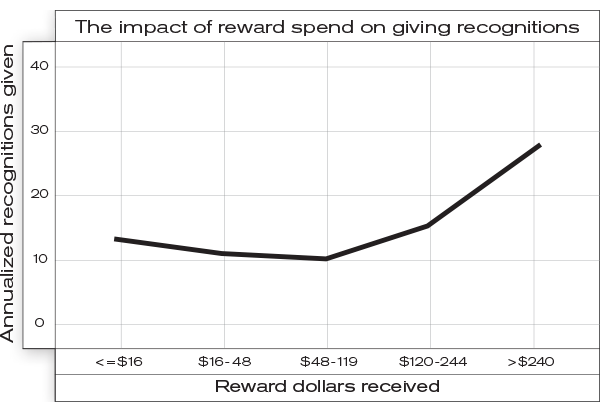When implemented correctly, these programs create a recognition-rich culture which can improve a company’s ability to attract and retain talent. However, the key to achieving these benefits is ensuring that employees are actively participating and engaging in the program. An engaged employee is more likely to feel appreciated, perform at a higher level and stay with the organization.
Investing in tangible rewards can directly impact employee engagement. Through an analysis of data from 19 recognition programs with over 3.2 million participants, BI WORLDWIDE Canada has found a correlation between reward spending and employee program engagement, specifically through program logins and peer recognitions.
The role of tangible rewards in employee engagement
Tangible rewards – such as points redeemable for merchandise, experiences, travel or educational training – play a critical role in not only enhancing the perceived value of recognition but also encouraging employees to engage with employee recognition programs. When employees can link their recognition with specific rewards, the program becomes more meaningful, leading to a higher likelihood of participation.
Program participation and engagement can be measured using two key metrics:
1. Program logins:
The frequency with which employees log in to review or redeem points, give recognition or check recognitions they’ve received.
2. Giving recognitions:
The act of employees recognizing the achievements of their peers.
Data insights: Engagement increases with higher rewards:
Employees were segmented based on the dollar value of the rewards they received annually and measured the corresponding program engagement levels in terms of logins and peer recognitions.
Program logins
Data shows a clear, linear increase in program logins as the value of rewards rises. Employees in the highest quintile (receiving points valued at over $244 annually) logged into the program almost 38 times per year, more than four times more compared to those receiving less than $16 in rewards annually (8.7 times per year).
Giving recognitions
The relationship between rewards and giving recognitions follows a slightly different pattern. Giving recognitions remained relatively steady until employees started receiving rewards in higher ranges. Once they surpassed points valued at $244 in annual rewards, they gave twice as many recognitions as their peers in lower reward groups.

Employees become more engaged in developing a recognition-rich culture in their organization when they feel adequately rewarded. Simply put, the more significant the rewards, the more engaged the employee is likely to be.
Balancing recognition with other program elements
While tangible rewards are important, they’re only one piece of the puzzle. Other components – such as frequent and high-quality communication about the program, peer-to-peer recognition opportunities and alignment with company values – are critical to fostering a recognition-rich environment. However, the financial data makes one thing clear: under-investing in employee recognition programs can limit their overall effectiveness.
Invest wisely to maximize engagement
The positive impact of employee recognition programs is well-established, but their success hinges on employees engaging in the program. Based on BI WORLDWIDE Canada’s analysis, a larger investment in tangible rewards can lead to more program participation and more peer-to-peer recognition, two key indicators of an engaged workforce.
So, how much should you spend on employee recognition realistically? One recent work survey by the Society for Human Resource Management (SHRM) found that the number should be greater than 1% of the payroll. The human resources (HR) professionals in the survey reported that the recognition programs were “excellent” when the budget was at least 1% or more of the payroll. Depending on the profitability, some organizations might spend more and even go up to 10% of the payroll.
Maximizing the return on employee recognition programs means ensuring that rewards are both meaningful and substantial enough to drive engagement. In this competitive talent landscape, a well-funded recognition program isn’t just a nice-to-have – it’s a smart investment in your people.
While every company’s culture is unique, great cultures share common traits: trust in leadership, support for employee wellbeing, a sense of purpose and belonging, and effective employee recognition. Remember, a great culture isn’t about having exposed brick walls – it’s about creating an environment that reinforces these pillars and your specific company values.
